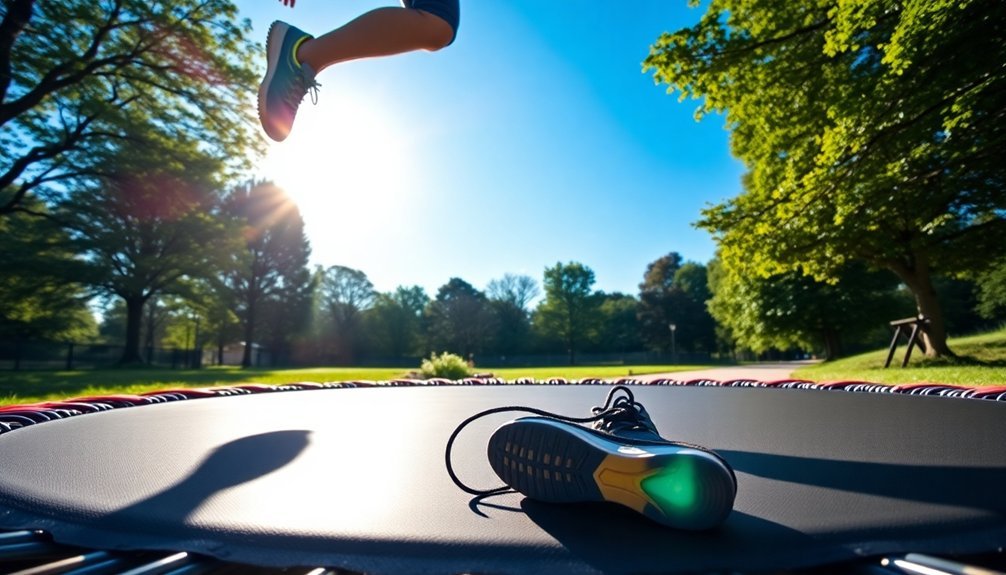Rebounders are perfect for joint health because they absorb up to 87% of impact forces while still delivering effective exercise benefits. When you bounce, the elastic surface creates a gentle environment that stimulates synovial fluid—your body's natural joint lubricant—without harsh landing forces. This reduces friction between joint surfaces, enhances nutrient delivery to cartilage, and strengthens supportive muscles around joints. Discover how this unique form of movement can transform your joint health while providing full-body conditioning.
The Science Behind Rebounding's Joint-Protective Effects

While traditional exercises like running can stress your joints, rebounding offers a uniquely protective alternative for joint health. The secret lies in the mini-trampoline's springy surface, which absorbs up to 87% of impact forces that would otherwise travel through your body.
When you bounce, the trampoline's elasticity creates a cushioning effect that dramatically reduces stress on your ankles, knees, hips, and spine. This gentle movement stimulates your joints without the harsh landing forces experienced during activities like jogging or aerobics. Regular rebounding sessions can significantly enhance joint mobility and flexibility over time.
Studies show rebounding provides effective cardiovascular and strength benefits without the joint strain. For those with arthritis or joint sensitivity, this low-impact approach allows you to maintain fitness while preserving joint integrity—making it an ideal exercise option for protecting your joints long-term.
How Rebounding Enhances Synovial Fluid Circulation
Your mini-trampoline workout creates gentle pumping action that circulates synovial fluid through your joints, delivering essential nutrients and removing waste products.
This enhanced fluid movement acts like a natural lubricant, reducing friction and allowing your joints to move more smoothly with less pain. The pressure distribution on the body is more balanced during rebounding, which further protects your joints from excessive strain.
Regular rebounding sessions can combat joint stiffness by maintaining ideal synovial fluid levels, giving you greater mobility and comfort in daily activities.
Fluid Movement Mechanisms
The pulsating motion of rebounding creates a unique environment where synovial fluid can circulate more effectively throughout your joints.
When you jump on a rebounder, you're alternating between moments of weightlessness and increased gravitational force, which stimulates synovial fluid movement within joint capsules.
This dynamic action enhances the delivery of nutrients to your cartilage while simultaneously removing waste products.
Unlike high-impact exercises that can damage joints, rebounding's elastic surface reduces stress while maintaining the beneficial fluid movement.
You'll experience improved joint mobility as the synovial fluid lubricates joint surfaces more thoroughly.
Regular rebounding sessions can strengthen the connective tissues surrounding your joints, providing better support and stability.
This combination of enhanced fluid circulation and tissue strengthening makes rebounding an ideal exercise for maintaining joint health long-term.
Studies show that rebounding significantly reduces impact stress on joints by 87% compared to running or jogging on hard surfaces.
Joint Lubrication Benefits
Understanding synovial fluid's critical role in joint health reveals why rebounding offers such profound benefits. This fluid acts like your body's natural joint lubricant, allowing bones to glide smoothly against one another without friction or pain.
When you bounce on a rebounder, you're stimulating synovial fluid production and circulation throughout your joints. Rebounding also creates alternating cycles of compression and decompression that act as a pump for nutrient circulation to joint tissues. Unlike high-impact exercises that can damage fragile joints, the gentle, rhythmic motion of rebounding bathes your joints in this nourishing fluid without harmful stress.
This increased circulation helps prevent stiffness while maintaining joint mobility. For arthritis sufferers, this benefit is particularly valuable. The enhanced synovial fluid movement reduces pain and wear on affected joints while supporting long-term mobility.
Your joints receive the lubrication they need without the impact they fear.
Bounce Against Stiffness
Joint stiffness affects millions of people worldwide, but rebounding offers a natural solution through enhanced synovial fluid circulation.
When you bounce on a mini trampoline, the repetitive motion creates a pumping effect that distributes synovial fluid throughout your joints, improving lubrication and reducing stiffness.
Unlike high-impact exercises that can damage already sensitive joints, rebounding absorbs up to 87% of the shock on each bounce.
This gentle motion allows you to strengthen surrounding muscles without straining your knees, hips, or spine. Your joints benefit from increased mobility while experiencing minimal stress.
For those with arthritis or age-related joint conditions, rebounding provides an effective way to maintain joint health. The Boogie Bounce rebounder features a patented T-bar handle that offers additional support and stability during your workout.
Just a few minutes daily can greatly improve your range of motion and decrease discomfort.
Building Supportive Muscle Strength Through Gentle Bouncing
Unlike high-impact exercises, rebounding builds muscle strength around your joints without stressing them, reducing injury risk by up to 80% compared to running.
Your core muscles naturally engage during bouncing, improving stability that's essential for proper joint alignment and function in daily activities.
You'll also develop multi-muscle strength throughout your legs, back, and buttocks as your body continually stabilizes on the unstable rebounder surface. This gentle workout is particularly beneficial for aging adults as it provides a low-impact workout suitable for those recovering from injuries while still effectively building strength.
Strengthens Supporting Muscles
When you bounce on a rebounder, your body engages multiple muscle groups that support and stabilize your joints. This repetitive bouncing motion strengthens your core, glutes, and lower back muscles, which considerably improves joint stability and alignment.
As you rebound, your leg and abdominal muscles work together to maintain balance, creating involuntary contractions that enhance lymphatic circulation and overall muscle resilience. These stronger muscles distribute weight more efficiently across your joints, reducing stress and potential damage.
Regular rebounding particularly benefits your deep stabilizing muscles and pelvic floor, improving posture and reducing spine strain. The springy surface of the mini trampoline absorbs impact shock, providing protection for vulnerable joints like knees, hips, and the spine.
You'll notice enhanced balance and coordination that translates to better movement patterns in daily activities. This thorough muscle engagement is especially valuable for older adults, as it supports healthier aging and reduces injury risk.
Low-Impact Muscle Development
Rebounding offers a remarkable alternative to traditional strength training by allowing you to build essential support muscles without subjecting your joints to harmful impact forces. You'll engage multiple muscle groups simultaneously during gentle bouncing sessions that absorb up to 87% of impact compared to hard surfaces. Consistent rebounding practice can help improve your endurance and coordination over time.
| Muscle Group | Rebounding Benefit |
|---|---|
| Core muscles | Activates deep stabilizers that protect spine and joints |
| Leg muscles | Strengthens quadriceps and hamstrings without joint strain |
| Stabilizers | Improves balance through constant micro-adjustments |
| Back muscles | Engages erector spinae without compression |
| Full body | Promotes muscle tone without excessive bulk |
Your muscles will develop functional strength through dynamic range-of-motion movements that simultaneously enhance flexibility. This approach provides cardiovascular benefits while building supportive muscle that helps maintain joint integrity for years to come.
Core Stability Benefits
Core stability serves as the foundation for all movement and joint health, a benefit that becomes immediately apparent during your first session on a rebounder.
When you bounce, your deep core muscles engage automatically to maintain balance, strengthening your abdominal wall and lower back simultaneously.
You'll notice improved posture as rebounding strengthens the muscles supporting your spine, reducing strain on your joints.
This dynamic activity also enhances your proprioception—your body's ability to sense its position in space—which translates to better balance in everyday activities.
The unstable surface of a rebounder challenges your stabilizing muscles in ways traditional exercises can't, creating resilience throughout your body's support system.
Research shows that trampoline workouts reduce impact force on joints by approximately 80% compared to activities like running, allowing you to protect your joints while still getting cardiovascular benefits.
Best of all, these benefits come without the harsh impact of running or jumping on hard surfaces, making rebounding ideal for long-term joint protection.
Cardiovascular Benefits Without Joint Strain
Unlike traditional high-impact cardio exercises, mini-trampolines offer a unique solution for fitness enthusiasts concerned about joint health.
Mini-trampolines provide a joint-friendly alternative to high-impact workouts for health-conscious exercisers seeking effective cardio options.
When you bounce on a rebounder, you'll experience up to 80% less impact on your joints compared to running or walking on pavement, while still effectively strengthening your heart muscles.
You'll reach your target heart rate zones with considerably less stress on your body. The gentle bouncing motion increases blood circulation, delivering more oxygen and nutrients to your cells while improving your cardiovascular performance. Rebounding provides a low-impact aerobic exercise that can be performed on a mini-trampoline in the comfort of your own home.
Over time, you'll notice a lower resting heart rate and improved stamina.
What makes rebounding especially valuable is that it feels less strenuous than it actually is. You're getting all the heart-healthy benefits of aerobic exercise without the joint-damaging impact of traditional cardio workouts.
Rebounding vs. Traditional Cardio: A Joint Health Comparison

When comparing exercise options for joint health, traditional cardio workouts often fall short against the gentle yet effective bouncing of rebounders.
Unlike treadmills and ellipticals, rebounders reduce impact by up to 87%, minimizing joint wear and tear while maximizing cardiovascular benefits.
You'll engage more muscle groups simultaneously on a rebounder than with most traditional equipment, creating a more efficient full-body workout.
NASA research confirms rebounding delivers comparable cardiovascular benefits to running in less time without the joint strain.
For those with arthritis or recovering from injuries, rebounding's gentle bounce stimulates synovial fluid circulation, lubricating joints and enhancing mobility.
Plus, you'll enjoy the added bonus of lymphatic stimulation – a unique benefit not found in conventional cardio equipment that supports both immune function and detoxification.
Studies have shown that rebounding can be particularly beneficial for people with knee osteoarthritis since the springy surface absorbs shock that would otherwise stress already painful joints.
Getting Started: Rebounder Exercises For All Mobility Levels
Initiating a rebounder fitness journey doesn't require elite athletic ability or perfect joints. Before you begin, consult your doctor to verify rebounding is safe for your specific health conditions.
Choose a high-quality mini-trampoline designed to minimize impact and protect your joints during workouts.
Start with these beginner-friendly exercises that accommodate various mobility levels:
- Easy bouncing – Simply stand and gently bounce without your feet leaving the mat
- Marching in place – A safe starting point for those with knee arthritis that minimizes impact
- Side-to-side movements – Activate different muscle groups while maintaining stability
Remember to start with short sessions of 5-10 minutes and gradually increase duration as your body adapts to this new form of exercise. Studies show that rebounding can be more effective than walking for osteoarthritis pain relief.
Frequently Asked Questions
How Long Should Seniors Rebound Daily for Optimal Joint Benefits?
You should start with just 5 minutes daily and gradually increase by one minute weekly, aiming for 20-minute sessions. Listen to your body and break sessions into shorter intervals if needed for comfort.
Can Rebounding Worsen Existing Joint Inflammation or Injuries?
Yes, rebounding can worsen existing joint inflammation or injuries if done incorrectly. You'll need to start gently, use proper technique, and consult your healthcare provider if you have severe joint conditions.
Are Mini-Trampolines Covered by Insurance for Arthritis Patients?
Most health insurance plans don't cover mini-trampolines for arthritis patients. You'll likely need to purchase one yourself. Check with your specific insurance provider, as coverage policies vary widely between companies.
What Safety Features Should Arthritis Patients Look for in Rebounders?
Look for rebounders with safety handles, stable bases with rubber-tipped legs, non-slip surfaces, and appropriate weight capacity. You'll also want adjustable height options and a comfortable, shock-absorbing jumping surface for your arthritis.
How Does Rebounding Compare to Water Therapy for Joint Health?
Rebounding offers low-impact strengthening while water therapy provides zero-impact movement. You'll find water therapy gives immediate pain relief, but rebounding's gravity-based exercise builds joint-supporting muscles more effectively in your daily routine.
In Summary
You've discovered rebounding's secret: it's the perfect low-impact exercise that strengthens while it protects. You'll enjoy increased synovial fluid circulation, stronger supportive muscles, and cardiovascular benefits without the joint strain of traditional exercises. Whether you're managing arthritis, recovering from injury, or simply protecting your joints for the future, your rebounder offers an accessible way to bounce your way to better joint health.





Leave a Reply